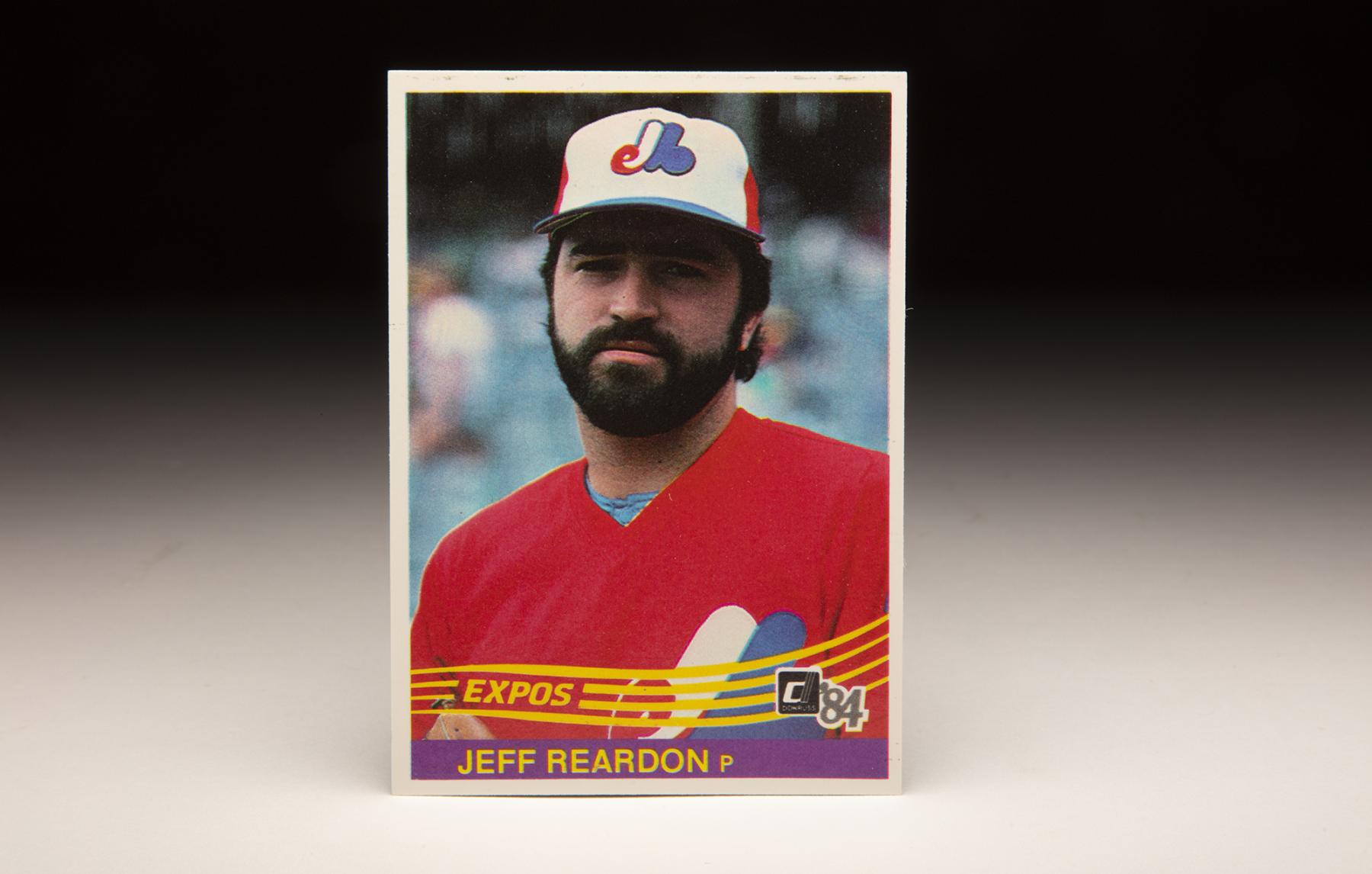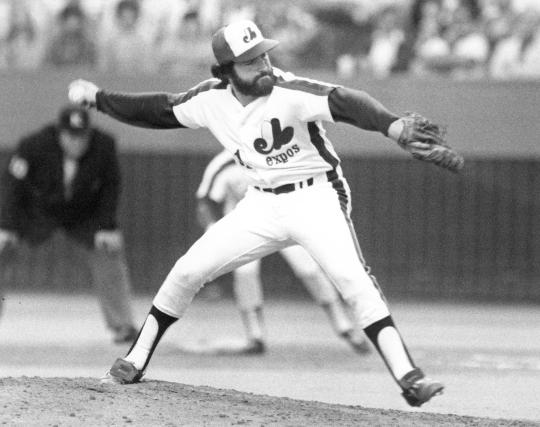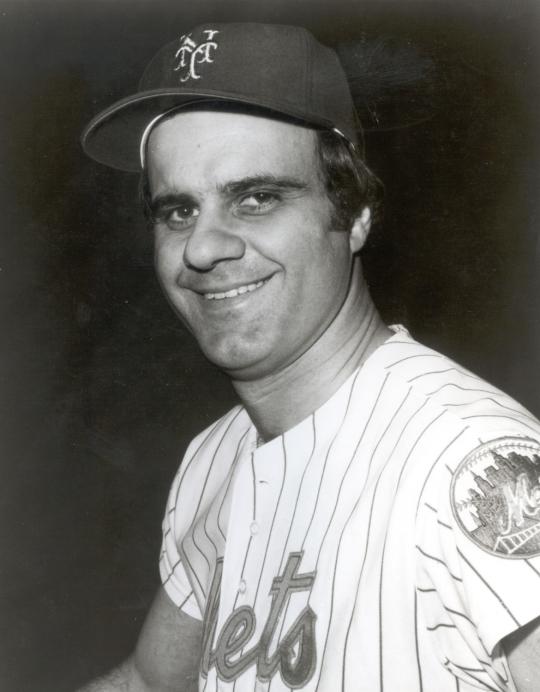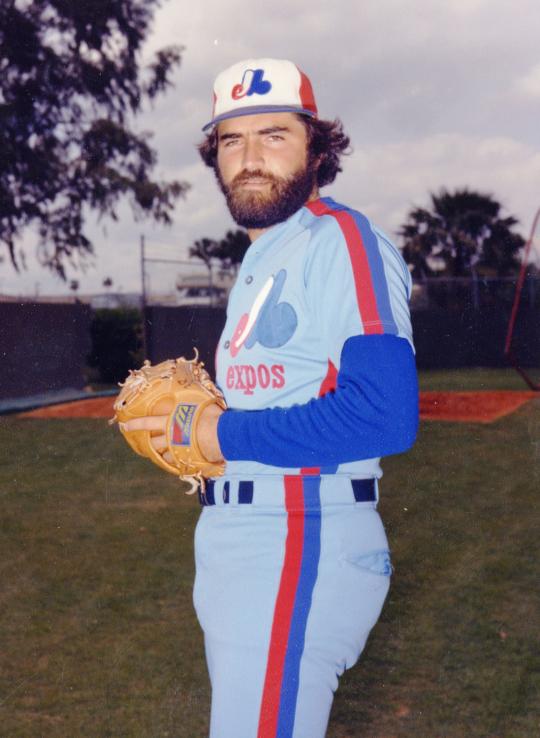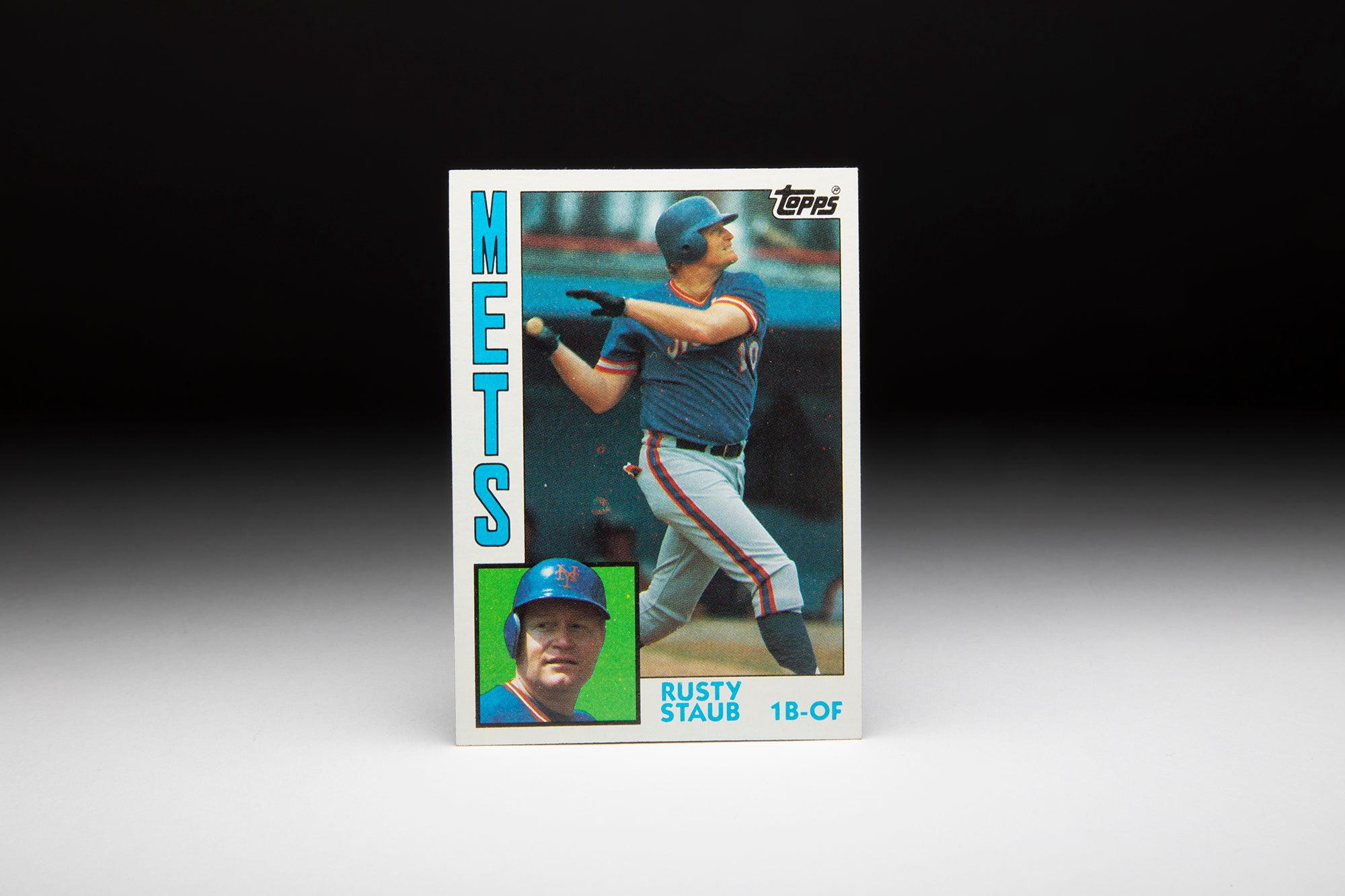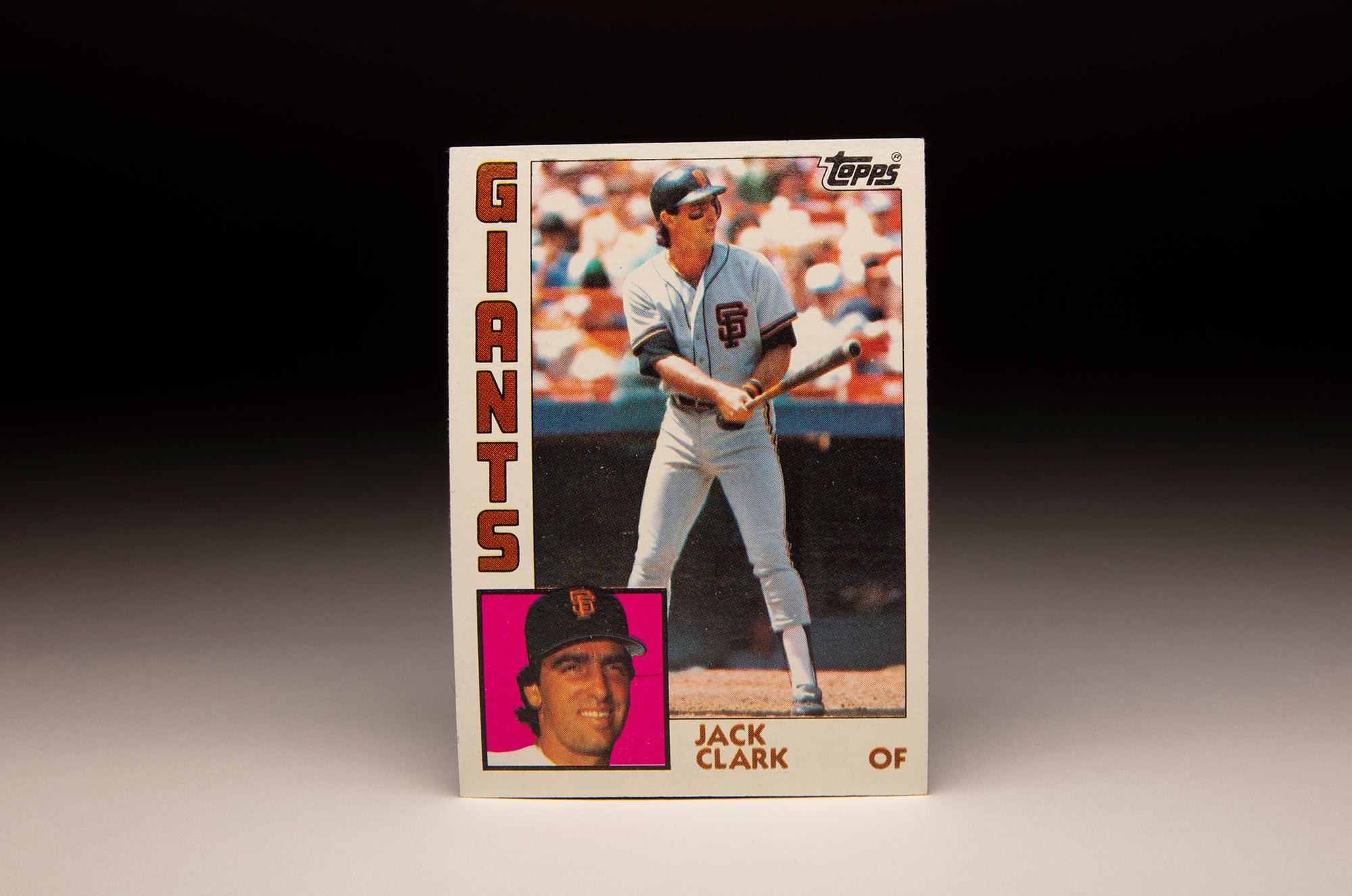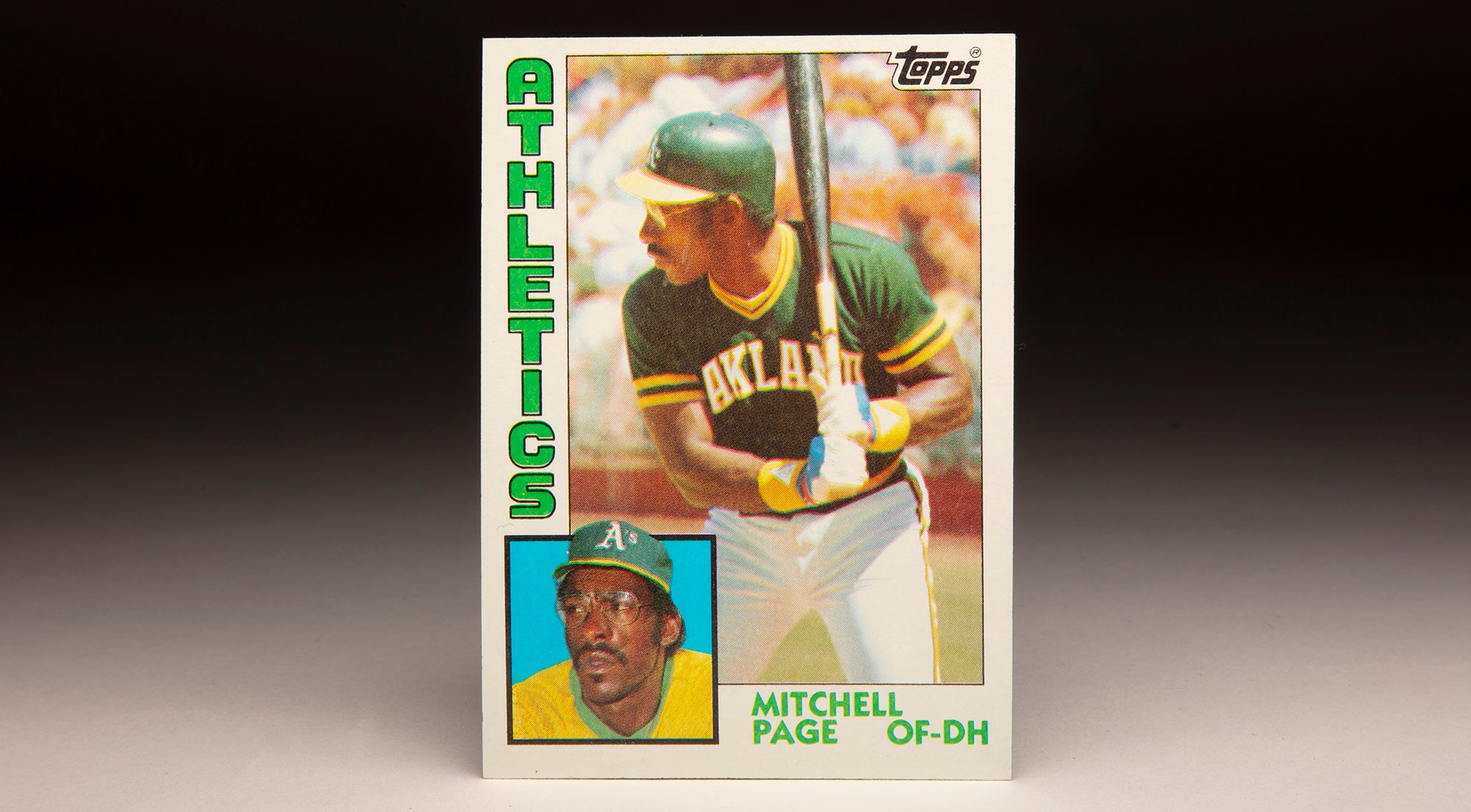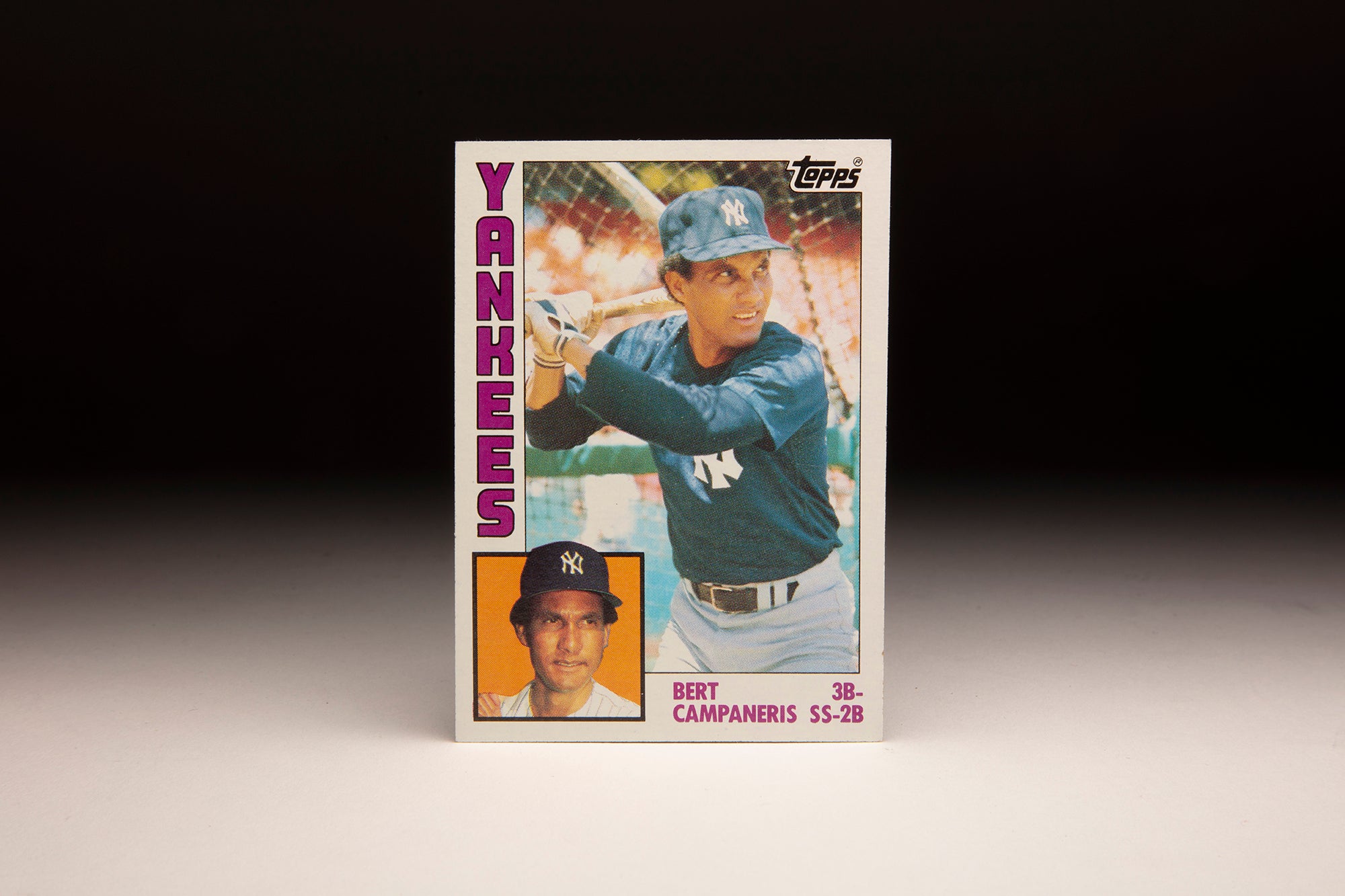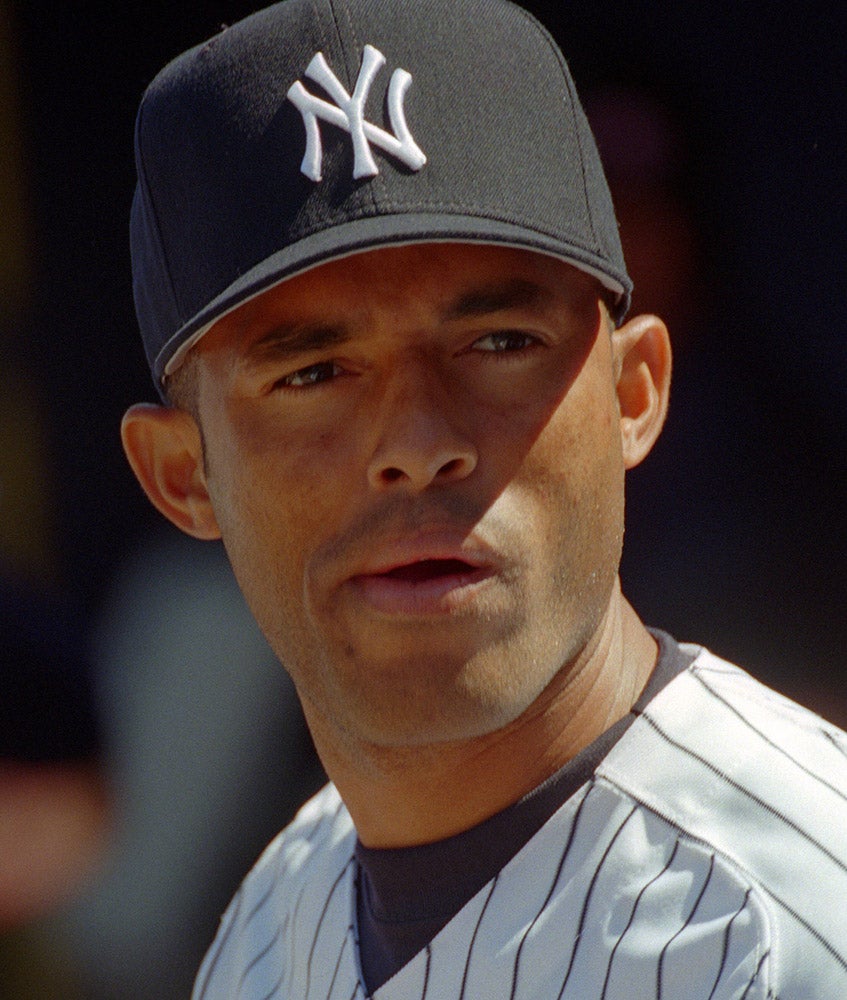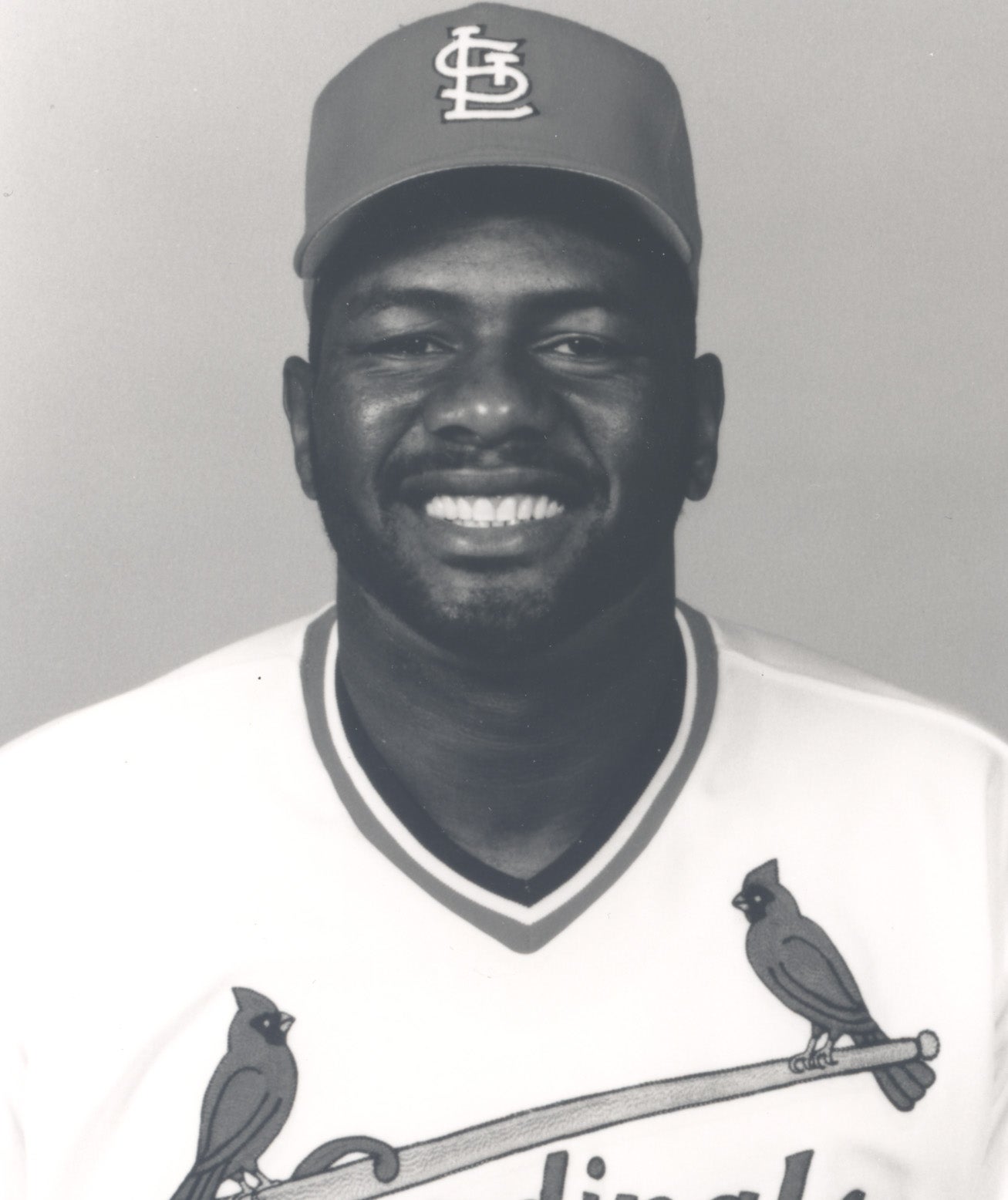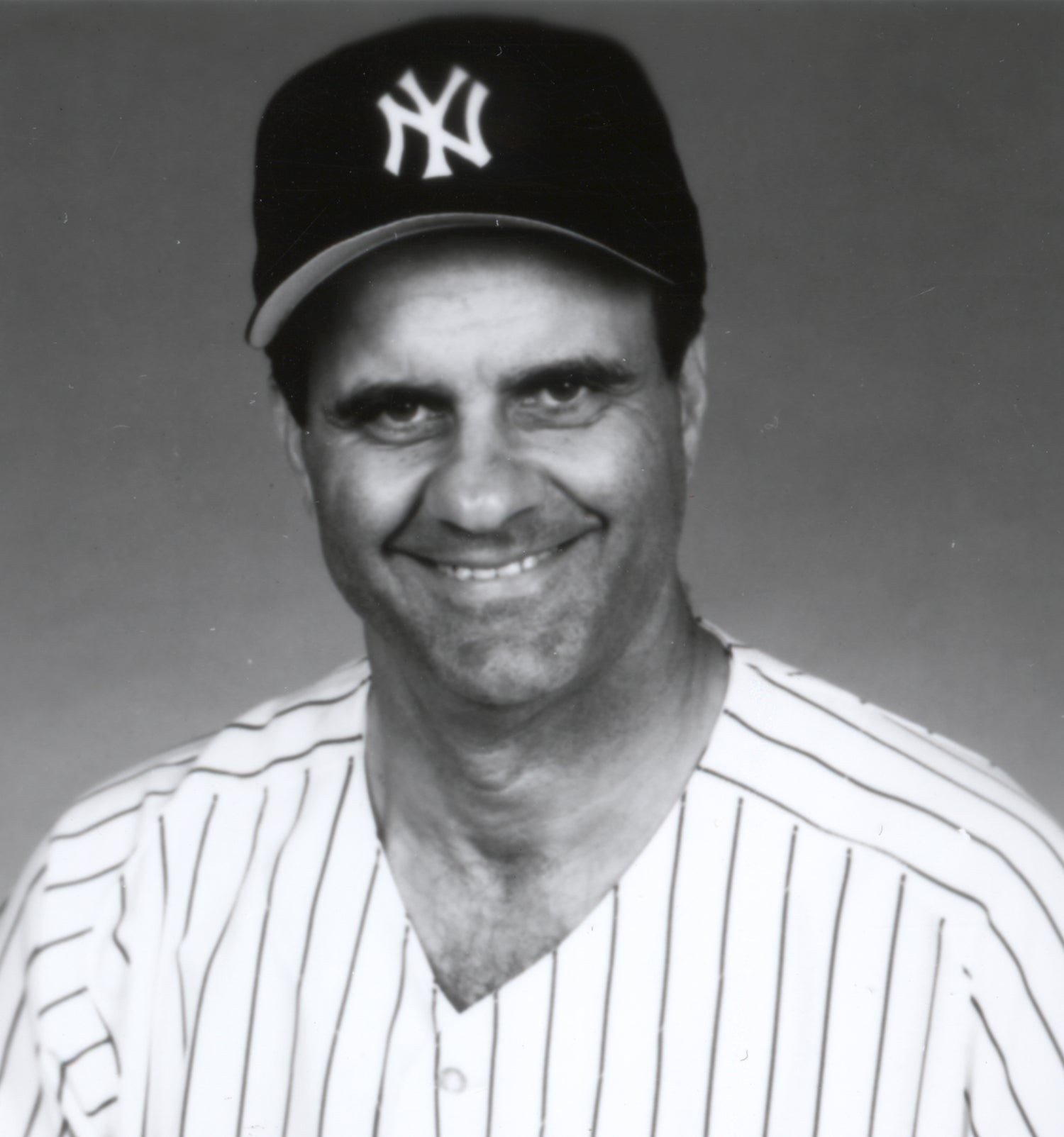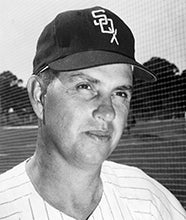- Home
- Our Stories
- #CardCorner: 1984 Donruss Jeff Reardon
#CardCorner: 1984 Donruss Jeff Reardon
The all-time MLB saves leaderboard looks a lot like a walk through the Hall of Fame Plaque Gallery.
From 1964-79, Hoyt Wilhelm topped the list with a final total of 228 saves (thought to be 227 during his time at No. 1). Then Rollie Fingers took over in 1980, holding the mark through the end of the 1991 season with a career mark of 341.
And in 1993, Lee Smith grabbed the lead, holding first place until Trevor Hoffman in 2006 – and before Mariano Rivera ascended to the top in 2011.
But at the end of the 1992 season, none of those five Hall of Famers ranked at the top of the saves list. Instead, the mark belonged to Jeff Reardon, who was undisputedly one of the most consistent closers of his time.
Born Oct. 1, 1955, in Pittsfield, Mass., Reardon grew up in nearby Dalton. As a high school junior, Reardon pitched a no-hitter for Wahconah Regional High School, striking out 21 batters over nine innings with his blistering fastball. Box score reports of the game reveal that future Expos, Red Sox and Orioles general manager Dan Duquette appeared in the same game for Wahconah as a pinch hitter.
Be A Part of Something Greater
There are a few ways our supporters stay involved, from membership and mission support to golf and donor experiences. The greatest moments in baseball history can’t be preserved without your help. Join us today.
Official Hall of Fame Merchandise
Hall of Fame Members receive 10% off and FREE standard shipping on all Hall of Fame online store purchases.
As a senior, Reardon fanned 24 batters in a nine-inning contest.
Reardon was selected by the Expos in the 23rd round of the 1973 MLB Draft but followed his father’s advice and enrolled at the University of Massachusetts-Amherst, continuing his baseball career with the Minutemen. At UMass, Reardon led the team in strikeouts in each of his four seasons, finishing tied atop the school’s all-time list with 240 – breaking the mark held by another future big leaguer, Mike Flanagan. But despite three successful summer campaigns in the Cape Cod League – two of which he helped Cotuit win the league title – Reardon went undrafted in 1977.
On June 14, 1977, Reardon signed with the New York Mets as an amateur free agent. The Mets immediately sent Reardon to Class A Lynchburg, where he went 8-3 with a 3.30 ERA in 16 games, including 12 as a starter.
Then in 1978, Reardon tore through the Double-A Texas League, going 17-4 for Jackson with a 2.54 ERA, leading the league in wins and earning the Topps Texas League Player of the Year award.
But in a sign of things to come, Reardon started the season in the bullpen before moving to the rotation.
“I hope I’ve gotten the message across to the organization,” Reardon told the Clarion-Ledger of Jackson, Miss. “I hope this shows them I belong in the rotation.”
When Spring Training of 1979 arrived, however, Reardon was back in the bullpen – but it was in big league camp with the Mets. New York manager Joe Torre recommended that Reardon, who suffered from a chronic back injury, be groomed as a reliever starting in 1979.
“I was impressed with him,” Torre told the New York Daily News. “He throws hard and he’s got guts.
“The first time I saw him was in the Instructional League in October of ’78, and he immediately reminded me of Catfish Hunter. He’s built a little like him, his motion is like Catfish’s and he’s got a fastball that sneaks up on you.”
Despite pitching well in exhibition games in 1979, Reardon was sent to Triple-A Tidewater, where he was 5-2 with a 2.09 ERA in 30 games – all but one coming in relief.
He made his big league debut for the Mets on Aug. 25, 1979, allowing two runs in one inning against the Reds while taking the loss. But in his final 17 games of the season, Reardon allowed just two earned runs over 19.2 innings while earning two saves and his first big league victory.
In 1980, Torre installed Reardon as a set-up man in front of Neil Allen – and Reardon responded with an 8-7 record with six saves and a 2.61 ERA over 110.1 innings. His 101 strikeouts were second on the Mets, trailing only the 109 recorded by starter Pete Falcone.
Reardon finished sixth in the National League Rookie of the Year voting.
But on May 29, 1981, the Mets finalized a trade that had been discussed the previous winter, sending Reardon and Dan Norman to the Expos for slugging outfielder Ellis Valentine.
“It was a shock,” Reardon, who learned of the trade during a game against the Cubs, told the Daily Times of Mamaroneck, N.Y. “I’m so young…didn’t think they’d give me up. I guess they got a good ballplayer in return. I had a lump in my throat when (Mets general manager Frank Cashen) told me.”
The Expos, who had finished agonizingly close to National League East titles in both 1979 and 1980, installed Reardon as their closer – with the expectation that his presence would push the Expos over the top.
“(Expos general manager John) McHale talked to me, and he said I’d be their ace in the pen,” Reardon said. “That’s what I want.”
Reardon proved to be exactly what the Expos needed, going 2-0 with six saves and a 1.30 ERA in 25 games during a season interrupted by a strike. But for Reardon, labor issues were the least of his concerns. During the work stoppage, Reardon’s father, John, suffered a heart attack and passed away on June 19.
“The first time I saw him was in the Instructional League in October of ’78, and he immediately reminded me of Catfish Hunter. He’s built a little like him, his motion is like Catfish’s and he’s got a fastball that sneaks up on you.” - Then-Mets manager Joe Torre (pictured above) on Jeff Reardon. (National Baseball Hall of Fame and Museum)
Share this image:
When Reardon pitched three innings and recorded a save in the Expos’ 7-4 division-clinching win over the Mets on Oct. 3, his thoughts were with his father.
“I was praying that my father could see me in the ninth inning winning the championship,” Reardon told the Associated Press.
Reardon collected two saves in the Expos’ win over the Phillies in the NLDS. But he allowed three runs in one inning of work in Game 1 of the NLCS vs. the Dodgers and did not pitch in the rest of the series due to his achy back. In Game 5, Expos manager Jim Fanning called on starting pitcher Steve Rogers to relieve in the ninth inning of a 1-1 tie – and Rogers surrendered a home run to Rick Monday that put the Dodgers in the World Series.
But with Reardon now fully established as the team’s closer, the Expos were picked by many as the division favorites in 1982. Reardon went 7-4 with a 2.06 ERA and 26 saves in 75 games, but the Expos finished in third place with a record of 86-76. He was 7-9 with a 3.03 ERA and 21 saves in 1983, but once again the Expos finished third.
Meanwhile, Expos fans took out their frustrations by booing Reardon’s wife, Phebe, when she appeared on field at Olympic Stadium on July 28, 1983, as part of a pitch for a food drive between games of a doubleheader against the Cardinals. Reardon had forced home the winning run with a walk in the opener.
Phebe Reardon left the field in tears.
Still, Expos management continued to express support for their closer. On Jan. 30, 1984, Reardon – who was two years away from free agency – signed a four-year deal with the Expos worth just shy of $3 million, including an option for a fifth year.
“No. 1, we’re giving him a message of what we think of him,” John McHale told the Berkshire Eagle. “And No. 2, we’re putting stability in our pitching staff.
“It’s the confidence we have in Jeff. He’s one of the best in the league.”
Reardon rewarded McHale’s faith by going 7-7 with 23 saves and a 2.90 ERA in 1984. Then in 1985, Reardon led the big leagues with 41 saves while posting a 2-8 record. He finished seventh in the NL Cy Young voting, received some NL Most Valuable Player votes and was named to his first All-Star Game.
Reardon repeated his All-Star selection in 1986 but had his worst year statistically with a 3.94 ERA to go with a 7-9 record and 35 saves. Then, with one year plus an option year left on his contract, the Expos traded Reardon to the Twins on Feb. 3, 1987, also sending catcher Tom Nieto in a deal that brought Neal Heaton, Yorkis Pérez, Jeff Reed and a minor leaguer to Montreal.
“I never heard of those guys,” Reardon told the Gazette in Montreal.
Reardon joined a Twins team that finished in sixth place in 1986. But with veteran starters Bert Blyleven and Frank Viola anchoring the rotation, Reardon provided the missing piece.
“Jeff has just stabilized our whole ball club,” Blyleven told the Associated Press. “Last year, the role as far as the players in the bullpen was unknown. Now (the starting pitchers) want to get to Jeff Reardon.”
Though his ERA ballooned to a career-high 4.48 – largely due to a rough two-month stretch to start the season that saw his ERA sitting at 7.96 on June 5 – Reardon saved 31 games and won eight more for a Minnesota team that won the AL West title and advanced to the World Series by beating Detroit in the ALCS. Reardon collected two saves and a win against the Tigers, then allowed no runs in 4.2 innings against the Cardinals in the World Series.
He retired the Cardinals in order in the ninth inning of Game 7, inducing Willie McGee to ground out to third base to clinch the title.
“He gives everybody a lot of confidence – the pitchers, ballplayers, everybody,” Twins manager Tom Kelly told the Associated Press. “He’s going to have his bad days as well as his good days, but he gives us all a lot of confidence.”
Despite his inflated ERA during the regular season, Reardon finished eighth in the AL Cy Young voting and 11th in the league’s Most Valuable Player balloting.
“When the game is on the line, he gets the ball,” Kelly said. “He doesn’t back off. He just gets the ball and here we go.”
In 1988, Reardon bounced back with a 2.47 ERA over 63 appearances, saving 42 games while posting a 2-4 record and earning his third All-Star Game selection. With his contract set to expire, the Twins and Reardon agreed to a one-year extension for 1989. But when they were unable to reach a further agreement, Reardon let it be known that he would leave as a free agent after the 1989 campaign. The Twins made no move to trade him, and Reardon finished the year with a 5-4 record, 31 saves and a 4.07 ERA.
On Dec. 6, 1989, Reardon returned home to Massachusetts by signing a three-year deal with the Red Sox worth a reported $6.8 million.
“It’s a dream come true,” Reardon told the Boston Globe. “I’ll get to come home, and that’s something my wife and I have always wanted to do.”
At the time he signed with Boston, Reardon was the only pitcher in big league history with at least five straight 30-save seasons and the only pitcher to save 40 games in both the NL and the AL.
The deal meant the end of Lee Smith’s tenure as the Red Sox’s closer, and on May 4, 1990, the Red Sox traded Smith to the Cardinals in exchange for Tom Brunansky. Reardon battled shoulder inflammation early in the season and missed all of August when his back acted up – but still finished with a 5-3 record and 21 saves to go along with 3.16 ERA. The Red Sox won the AL East that year but were swept in the ALCS by the Athletics, with Reardon allowing two runs over two innings in his only appearance.
Reardon posted his third 40-save season in 1991, going 1-4 with a 3.03 ERA and those 40 saves in 57 games while earning his fourth All-Star Game selection. On June 15, 1992, Reardon closed out Boston’s 1-0 win over the Yankees, recording his 342nd save to pass Fingers for the top spot on the all-time list.
Reardon was carried off the field by his teammates following the last out. His cap from the game and a glove from that season are a part of the Hall of Fame’s collection.
“I was the most nervous I’ve ever been other than a World Series,” Reardon told the Boston Globe. “My heart was pumping.”
Reardon was 2-2 with 27 saves in 46 games on Aug. 30, 1992, when the Braves – in need of bullpen help as they chased a second-straight NL West title – acquired Reardon for Nate Minchey and Sean Ross.
Energized by the deal, Reardon went 3-0 with three saves and a 1.14 ERA in 14 games as Atlanta advanced to the postseason. Then in the NLCS vs. the Pirates, Reardon made three scoreless appearances, saving Game 4 and winning Game 7 when Sid Bream scored from second base on Francisco Cabrera’s single in the bottom of the ninth. Cabrera was pinch-hitting for Reardon.
Reardon did not fare as well in the World Series against the Blue Jays, taking the loss in Game 2 and allowing a walk-off single to Candy Maldonado in Game 3, which was his final game of the series.
A free agent once again following the season, Reardon signed a minor league deal with the Reds on Jan. 19, 1993. He made the big league club – which necessitated the shaving of his trademark beard, as the Reds did not allow facial hair.
Now a set-up man who sometimes relied on a knuckleball, Reardon did not earn his first save of the season until April 26. By that point, Lee Smith had passed him for the top spot – and Smith never relinquished the lead despite Reardon saving six games in 20 days from April 26 through May 15. Reardon finished the year with a 4-6 record, 4.09 ERA and eight saves in 58 games.
Reardon signed a minor league deal with the Yankees on Feb. 15, 1994, and made the Opening Day roster. But after allowing nine earned runs over 11 appearances – including three against the Angels in one-third of an inning in the final appearance of his career – Reardon was released on May 6.
“I appreciate the way he handled everything,” Yankees manager Buck Showalter told the Hartford Courant. “But there’s no way I would want Jeff to pitch as a mop-up guy.”
Reardon finished with a 73-77 record and 3.16 ERA over 880 games – all in relief. His 367 saves ranked second on the all-time list when he retired and he remains one of only 13 pitchers with at least 350 saves.
And for about 10 months in 1992 and 1993, Jeff Reardon could verifiably claim to be the most successful relief pitcher in history.
“I’ve never been into personal stats,” Reardon told the Courier-News of Bridgewater, N.J., during his final big league season in 1994. “If there’s one thing I’d like people to remember about me, it’s that I never refused to take the ball.”
Craig Muder is the director of communications for the National Baseball Hall of Fame and Museum

